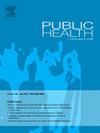肺栓塞与癌症死亡的关联日益增加:一项为期7年的美国全国分析
IF 3.2
3区 医学
Q1 PUBLIC, ENVIRONMENTAL & OCCUPATIONAL HEALTH
引用次数: 0
摘要
目的探讨肺栓塞(PE)与癌症死亡的关系。研究设计:回顾性、观察性。方法:我们使用WONDER数据库的数据进行回顾性分析,分析2018年至2024年间美国与癌症和肺水肿相关的死亡人数,计算死亡率并使用泊松回归分析评估时间趋势。在WONDER数据库过去7年中记录的49959437例癌症相关死亡中,96366例与PE相关,累计死亡率为1.94%。与pe相关的癌症死亡率最高的是子宫恶性肿瘤,其次是胰腺、胃、肺、乳腺、结肠和直肠以及脑部肿瘤。与癌症死亡相关的PE比例从2018年的1.61%上升到2024年的2.21%,年均增长5.2%。泊松回归分析显示上升趋势有统计学意义(r = 0.930;p & lt;0.001)。结论:我们的研究结果表明,加强PE预防仍然是一个重要的临床目标,但也支持需要进一步的研究来阐明这种关联是否反映了因果关系。本文章由计算机程序翻译,如有差异,请以英文原文为准。
The increasing association of pulmonary embolism with cancer deaths: A seven-year, US-based, nationwide analysis
Objective
To establish the association between pulmonary embolism (PE) and cancer deaths.
Study design
Retrospective, observational.
Methods
We performed a retrospective analysis using data from the WONDER database, analyzing the number of deaths associated with cancer and PE between 2018 and 2024 in the US, calculating mortality rates and assessing temporal trends using Poisson regression analysis.
Results
Out of 4,959,437 cancer-related deaths recorded in the WONDER database during the past seven years, 96,366 were associated with PE, yielding a cumulative mortality rate of 1.94 %. The highest rate of PE-associated cancer deaths was found for malignancies of uterus, followed by pancreas, stomach, lung, breast, colon and rectum, and brain. The proportion of PE associated with cancer deaths increased from 1.61 % in 2018 to 2.21 % in 2024, with average annual increase of 5.2 %. Poisson regression analysis revealed a statistically significant upward trend (r = 0.930; p < 0.001).
Conclusions
Our findings suggest that enhancing PE prevention remains an important clinical goal, but support also the need for further research to clarify whether this association reflects a causal relationship.
求助全文
通过发布文献求助,成功后即可免费获取论文全文。
去求助
来源期刊

Public Health
医学-公共卫生、环境卫生与职业卫生
CiteScore
7.60
自引率
0.00%
发文量
280
审稿时长
37 days
期刊介绍:
Public Health is an international, multidisciplinary peer-reviewed journal. It publishes original papers, reviews and short reports on all aspects of the science, philosophy, and practice of public health.
 求助内容:
求助内容: 应助结果提醒方式:
应助结果提醒方式:


